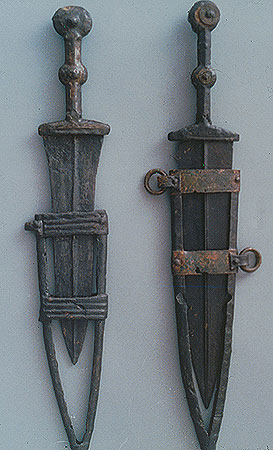Celtiberians
== Celtiberians ==
The Celtiberians were a group of Celtic tribes inhabiting the central-eastern part of the Iberian Peninsula during the final centuries BCE. They are considered to be a fusion of Celtic and Iberian cultures, which resulted in a unique cultural and linguistic identity.
Origins[edit | edit source]
The origins of the Celtiberians are traced back to the migration of Celtic tribes into the Iberian Peninsula around the 9th century BCE. These tribes intermingled with the indigenous Iberians, leading to the emergence of the Celtiberian culture. The primary area of Celtiberian settlement was the region known today as Castile and León, Aragon, and parts of Valencia and La Rioja.
Culture[edit | edit source]
Celtiberian culture was characterized by a blend of Celtic and Iberian elements. They spoke the Celtiberian language, which is a member of the Celtic language family. Their society was organized into tribes, each led by a chieftain. The Celtiberians were known for their warrior culture, and they played a significant role in the Second Punic War as mercenaries for both the Roman Republic and Carthage.
Art and Craftsmanship[edit | edit source]
Celtiberian art and craftsmanship were highly developed, particularly in metalwork. They are renowned for their intricate jewelry, weapons, and armor. The falcata, a type of sword, is one of the most famous Celtiberian weapons. Their pottery and textiles also reflect a high degree of skill and aesthetic sense.
Religion[edit | edit source]
The religious practices of the Celtiberians were a syncretism of Celtic and Iberian beliefs. They worshipped a pantheon of gods and goddesses, many of whom were associated with natural elements and warfare. Archaeological sites have revealed numerous sanctuaries and altars, indicating the importance of religious rituals in their daily life.
Interaction with Rome[edit | edit source]
The Celtiberians came into significant contact with the Roman Republic during the 2nd century BCE. This interaction was often marked by conflict, most notably the Celtiberian Wars (181-133 BCE). The most famous of these conflicts was the Siege of Numantia, where the Celtiberians resisted Roman conquest for several years before ultimately succumbing in 133 BCE. Following their defeat, the region was gradually Romanized, and the Celtiberian culture was assimilated into the broader Roman Empire.
Legacy[edit | edit source]
The legacy of the Celtiberians is evident in the archaeological remains scattered across the Iberian Peninsula. Their influence is also seen in the linguistic and cultural development of the region. The study of Celtiberian inscriptions has provided valuable insights into the early history of the Celtic languages and the cultural interactions in ancient Hispania.
Related Pages[edit | edit source]
- Celtic tribes
- Iberian Peninsula
- Second Punic War
- Roman Republic
- Celtiberian Wars
- Siege of Numantia
- Celtic languages
- Hispania
Categories[edit | edit source]
Search WikiMD
Ad.Tired of being Overweight? Try W8MD's physician weight loss program.
Semaglutide (Ozempic / Wegovy and Tirzepatide (Mounjaro / Zepbound) available.
Advertise on WikiMD
|
WikiMD's Wellness Encyclopedia |
| Let Food Be Thy Medicine Medicine Thy Food - Hippocrates |
Translate this page: - East Asian
中文,
日本,
한국어,
South Asian
हिन्दी,
தமிழ்,
తెలుగు,
Urdu,
ಕನ್ನಡ,
Southeast Asian
Indonesian,
Vietnamese,
Thai,
မြန်မာဘာသာ,
বাংলা
European
español,
Deutsch,
français,
Greek,
português do Brasil,
polski,
română,
русский,
Nederlands,
norsk,
svenska,
suomi,
Italian
Middle Eastern & African
عربى,
Turkish,
Persian,
Hebrew,
Afrikaans,
isiZulu,
Kiswahili,
Other
Bulgarian,
Hungarian,
Czech,
Swedish,
മലയാളം,
मराठी,
ਪੰਜਾਬੀ,
ગુજરાતી,
Portuguese,
Ukrainian
Medical Disclaimer: WikiMD is not a substitute for professional medical advice. The information on WikiMD is provided as an information resource only, may be incorrect, outdated or misleading, and is not to be used or relied on for any diagnostic or treatment purposes. Please consult your health care provider before making any healthcare decisions or for guidance about a specific medical condition. WikiMD expressly disclaims responsibility, and shall have no liability, for any damages, loss, injury, or liability whatsoever suffered as a result of your reliance on the information contained in this site. By visiting this site you agree to the foregoing terms and conditions, which may from time to time be changed or supplemented by WikiMD. If you do not agree to the foregoing terms and conditions, you should not enter or use this site. See full disclaimer.
Credits:Most images are courtesy of Wikimedia commons, and templates, categories Wikipedia, licensed under CC BY SA or similar.
Contributors: Prab R. Tumpati, MD






